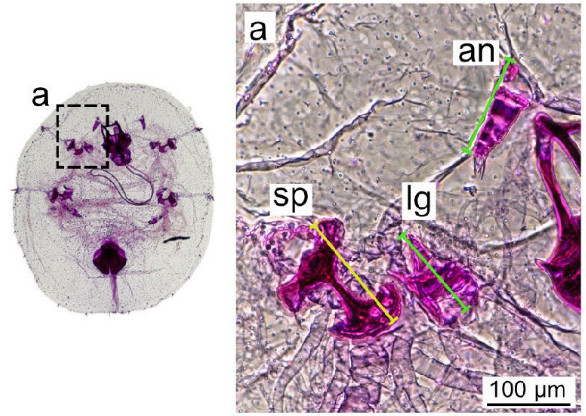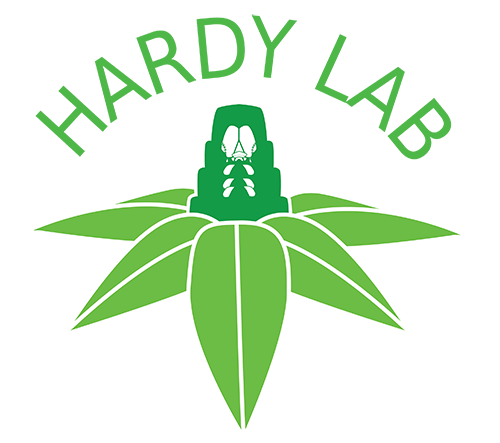Valid Names Results
Toumeyella coffeae Kondo, 2013 (Coccidae: Toumeyella)Nomenclatural History
- Toumeyella coffeae Kondo 2013: 39-51. Type data: COLOMBIA: Norte de Santander: municipio de Cucutilla, 5/2/2013, on roots of Coffea arabica, by M. Leal. Holotype, female, by original designation Type depository: Bogotá: Museo Entomológico Facultad de Agronomía, Universidad Nacional de Colombia; accepted valid name Notes: Paratypes. Same data as holotype 31 slides (28 adult females + 3 third-instar nymphs) (UNAB). Illustr.
Common Names
- Coffee-root scale KondoGa2022AP
- Escama de la raíz del café KondoGa2022AP
Ecological Associates
Hosts:
Families: 6 | Genera: 10
- Asteraceae
- Bidens | KondoGa2022AP
- Conyza | KondoGa2022AP
- Emilia | KondoGa2022AP
- Erato | KondoGa2022AP
- Fabaceae
- Leucaena | KondoGa2022AP
- Malvaceae
- Sida | KondoGa2022AP
- Rubiaceae
- Coffea | KondoGa2022AP
- Coffea arabica | Kondo2013
- Talinaceae
- Talinum | KondoGa2022AP
- Verbenaceae
- Stachytarpheta | KondoGa2022AP
- Verbena | KondoGa2022AP
Geographic Distribution
Keys
- CaballKo2024: pp.4 ( Adult (F) ) [Species associated with coffee roots in Colombia]
- Kondo2013: pp.40-41 ( Adult (F) ) [Key to genera of the Toumeyella-group based on adult females]
Remarks
- Systematics: First-instar nymphs of T. coffeae have five segmented antennae and resemble other species of Toumeyella. (Kondo, 2013) Slide-mounted adult female T. coffeae can be differentiated from other species of Toumeyella by possessing the following combination of character states: (i) perivulvar pores small, about same size as spiracular pores; (ii) all leg segments fused, except for claw; (iii) antennal segmentation indistinct, 2–4-segmented; (iv) stigmatic clefts well developed; with 3 stigmatic spines in each cleft, median spine slightly longer than lateral spines; (v) anal plates each with 1 or 2 apical setae; (vi) marginal setae sharply spinose, with parallel sides, near apex abruptly tapering to a point; (vii) a small sclerotic area. (Kondo & Garonna, 2022) often present just anterior to anal plates; and (viii) ventral tubular ducts restricted to perivulvar area.
- Structure: Body convex. Derm orange, brown to greyish green in color, with dark tesselations, but usually with mid-dorsum very lightly or not mottled; anal plates dark to reddish brown. Mature insects 1.5-4.2 mm in diameter, (Kondo, 2013). Slide-mounted adult female body oval to elongate oval, often narrowing anteriorly, 1.7–5.3 mm long, 1.1–4.1 mm wide; anal cleft about 1/4 of body length. Dorsal setae sharply spinose, straight or slightly curved. Dorsal microducts with a bilocular opening, each with a long terminal filament, scattered throughout dorsum. (Kondo & Garonna, 2022)
- Biology: This species is sexual because second-instar males have been found in one infestation. These coccids live and feed on roots and on underground parts of stems. (Kondo, 2013)
- Economic Importance: Toumeyella coffeae is the only species in the genus known from the roots and root crown of its host. (Kondo and González, 2018) Large populations of the scale may cause various symptoms, including chlorosis, leaf fall, wilting of twigs and, in some cases, plant death. (Kondo & Garonna, 2022)
- General Remarks: Detailed description, color photographs and illustration in Kondo, 2013.
Illustrations
Citations
- Caball2021: distribution, host, 343
- CaballKo2024: illustration, key, morphology, 4-5
- CaballRaGi2018: distribution, host, illustration,
- CaballRaRa2020: distribution, history, 166
- Kondo2013: distribution, host, 39-51
- Kondo2019: distribution, economic importance, 128, 129
- KondoGa2022AP: control, diagnosis, distribution, economic importance, host, illustration, taxonomy, 340-341
- KondoGo2014: host, taxonomy, 1
- KondoGo2018: distribution, host, list, 6
- KondoWa2022a: distribution, host, list, 13
- SuarezGiBe2018: distribution, host,



